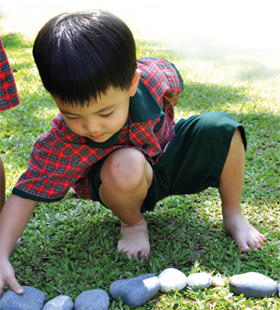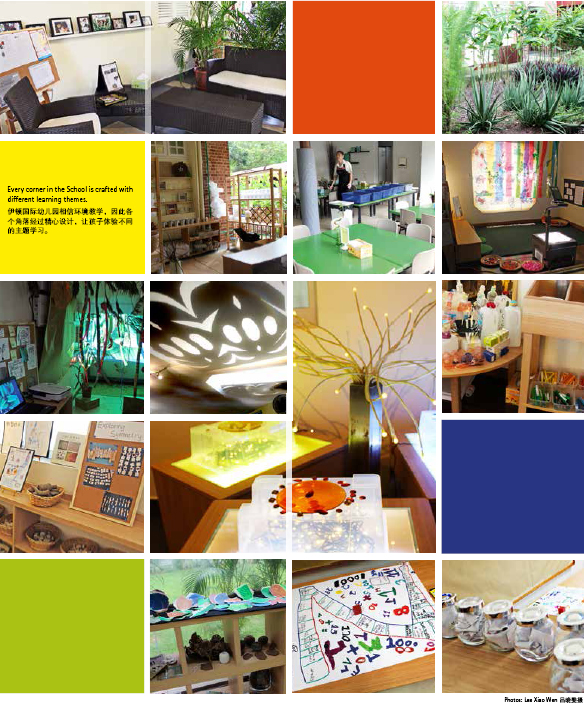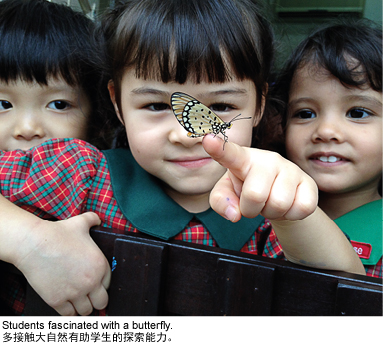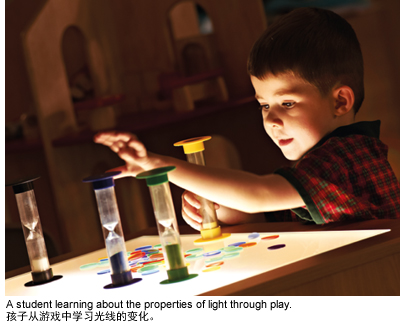 Stepping into EtonHouse Mountbatten 718
Stepping into EtonHouse Mountbatten 718
There was a sense of home as we stepped into the cosily furnished parents’ waiting area at EtonHouse Mountbatten 718. Ms Victoria Newman, EtonHouse Mountbatten 718’s Pre-School Director, explained that the School understands the anxiety felt by parents when leaving their children in pre-school for the first time. “We put tea, coffee and magazines here, and the parents are invited to come and wait here for a while so that we can keep them informed as to how their child is doing during the day. As the time goes on and they get to know other new families, they will often move to somewhere else close by and there is a point when they can feel comfortable leaving their child.”
Next to the waiting area was the School’s recycling corner, which was decorated with various recycled materials. The corner is very popular with students who enjoy finding things to create there. It also “changes every day”, said Ms Newman. “Teachers spend a lot of time thinking about the space, and it’s exciting for the children to come and see what’s been brought in. The School values the environment and recycling, and wants to inculcate this same spirit in its students, too.”
Parents are encouraged to drop off items for recycling with their children. Indeed, one of the School’s aims is to make parents feel included as well. “We place value on our parents being part of our community,” Ms Newman said.
The School produces a series of newsletters to keep parents informed of their children’s learning. “Every fortnight, the Core Teacher in the classroom writes a newsletter,” said Ms Newman. “In between, the Associate Teacher will compile a picture newsletter. The idea is that parents can look at it at home, and ask their children to explain what’s happening in it, so it encourages the children to share their learning with parents at home.” The newsletters also contain some Mandarin content written by the School’s Mandarin teachers. “This is to share the children’s inquiries through Mandarin, but we provide translations so that the parents can access these thoughts.”
The importance of Mandarin continues to spread across the globe, and Mrs Ng Gim Choo, Founder and Managing Director of the EtonHouse International Education Group, understands all too well the importance of having a bilingual education even at the pre-school level. “This School puts an emphasis on bilingualism, so every class has a core English teacher, a Chinese teacher from China, and a local Associate Teacher,” Mrs Ng said.
“They basically come from three different countries, and they all have degrees or diplomas in Early Childhood Education. Traditionally, Mandarin is taught in a separate two-hour slot on the timetable. But for us the language is integrated. The Mandarin teacher will be in the classroom, and he or she will have very good rapport with the students, so it makes learning easier. They will also understand how the children learn and the English lessons they go through, and then they’ll be able to teach better. We find that the learning is more effective because it is integrated.”
But lessons do not just take place in the classroom. The dining area — a non-enclosed canteen — exemplifies this. “All the children will have their meals in this area,” said Ms Newman, “from the youngest at 18 months old to the oldest at six years old, but it is also a place where they can explore Mathematics and learn to be independent. The children will come in, take a cup, a plate, a bowl, a spoon, and whatever else they need. They’ll set the table for their friends, do lots of counting, get the food, and place the food on the table, and then their friends will come and they will start to serve themselves food, so there’s a high level of independence, which the children absolutely love. For them, this is a wonderful time. They’re talking, sharing their thinking, and being independent. This is why they’re here. All the children know how to access this area.”
Inquire, Think, Learn
The inculcation of independence and EtonHouse’s
 Inquire-Think-Learn curriculum approach can be seen throughout the School. Learning happens wherever children are able to explore and inquire. Inquire-Think-Learn curriculum approach can be seen throughout the School. Learning happens wherever children are able to explore and inquire.
We were led out of the dining area and shown the spice garden that was next to it. Pointing to the basil leaves and chilli plants, Ms Newman told us that the children grow the spices themselves, and that the responsibility of care was theirs too. “Over time, the children will forget to tend to the plants, and weeds will develop as a result. We purposely leave the weeds there so that they can learn about caring for plants.”
“Teachers are also encouraged to use the outside spaces as classrooms. There will be times when the children come out just to play freely with their friends but at other times, they will come out in small groups to do some reading together, tell a story, or even explore the garden. We’re really keen that children learn both inside and outside the classroom, that they know the other areas in the School and can access them,” Ms Newman added.
In addition, children are encouraged to participate in local communities outside of the School, and EtonHouse works closely with several of them to facilitate this. “We use our local community a lot. We’ve had swimming lessons in the pool across the road, we’ve had an on-going relationship with the ceramics studio which we’ve worked with very closely, sending clay over to be fired, and the children have been over to visit them. Our local community’s really important so the children should become familiar with it, and not just the School,” said Ms Newman.
We were later led to a sheltered area, where a Physical Education class was in progress. Although it was apparent that the children were enjoying themselves, it was a learning session for them too. “When they’re together in this sort of engagement, they’re exploring teamwork, collaboration, listening skills, cooperation, and all of these are very important to the overall approach we have,” said Ms Newman.
Going indoors, we were taken into a “virtual forest” — a little space beneath a flight of stairs with faux vegetation imaginatively constructed from simple craft materials, plastic screens, lemon grass, and a projector. Surprisingly, however, it wasn’t the teachers but the children who had conceived of it. “This was the children’s idea. They requested the space under these stairs. It used to have some furniture, but they wanted to explore it, so they created their own forest. This is part of their own inquiry — they chose the images they wanted to put on from the Internet, did their planning, and then with our art experts — they started to build their own forest.”
The classroom upstairs that we were shown next was no less brimming with creativity. Belonging to the same group of children responsible for the “virtual forest” downstairs, the room contained more than just their homework. To one side, a board displayed the children’s thoughts, expressed in both words and pictures, and Ms Newman emphasised that these were not finished products, but rather that they grew over time and changed with the children’s inquiry.
Inquiry-based learning is certainly an important feature of EtonHouse’s curriculum. Nearby were shelves of various resources and objects, which the children use to explore counting and symmetry. “You can see it’s a very literacy-rich environment, you can see all the different learning taking place through inquiry. We don’t teach subjects singularly — it’s all through the inquiry. It’s important that they find out the answer themselves, with our support. We don’t just give the children the answer,” said Ms Newman.
A constant fragrance within the room had a very calming effect, and this was important for the learning process too, according to Ms Newman. “It’s really important that it’s natural and calm, because children spend their whole day here. If we put too much colour into the room, it becomes very distracting.”
Nor is creative, inquiry-based learning confined to just Mathematics and Science. Leaving the building to go outside again we saw another class in which the youngest children were being given free rein to paint whatever they liked. “These are the youngest children exploring paint, and it’s important they explore it without adult intervention all the time, that they can just be free to move the brush,” said Ms Newman.
As our tour progressed, we were introduced to other learning aids. One which stood out was what Ms Newman called a “light area”. Originally another dining room, it had been re-fashioned into a space for children to explore the properties of light in their own time. “We provide opportunities for a lot of exploration with light. Light is very powerful for children.”
Another learning opportunity was shown to us when we arrived at our third classroom. Near the entrance was a shelf, on which stood jars containing strips of rolled-up paper. “It’s called the ‘I Can’ jar. In it, they’ll put a little note saying the things they can do, so over the year, as they are able to do more, they’ll write more notes and put them in. At the beginning of the year, there’s not very much in there, but as the year goes on there will be,” explained Ms Newman.
Ms Susannah McGuire, Assistant Principal of EtonHouse Mountbatten 718, who was with the group at the time, added, “Some of them are just beginning to learn to write, so there’s some phonetic and inventive spelling, but as the year goes on, it becomes conventional.
“It allows us to discover more about their development.”
The Reggio Emilia Approach
EtonHouse’s Inquire-Think-Learn approach is not a new concept. At the end of our tour we were led into a smaller room where we were joined by Ms Germaine Chow, a teacher at EtonHouse Mountbatten 718 who holds a degree in Early Childhood Education from the University of Warwick. Along with Ms McGuire, Ms Chow went to Italy to learn more about the Reggio Emilia Approach.
 Started by the late Loris Malaguzzi in the aftermath of the Second World War, the Approach is based on the belief that children are naturally capable inquirers who actively construct their world, and are not just passive receptacles for knowledge. Started by the late Loris Malaguzzi in the aftermath of the Second World War, the Approach is based on the belief that children are naturally capable inquirers who actively construct their world, and are not just passive receptacles for knowledge.
According to both Ms Chow and Mrs Ng, the Reggio Emilia Approach quickly became a guiding inspiration for how things are done at EtonHouse. “The basis of it all is the image of the child. We really think that children are competent and capable, so rather than teaching them and giving them knowledge, the role of the teacher changes, so you’re like partners in learning. If you look around EtonHouse, you’ll see that the child and the teacher work alongside each other,” Ms Chow elaborated.
“The literacy and numeracy becomes so rich and so meaningful when they’re interested in it,” said Ms Chow. “For example, in my class someone brought in a water bottle, and then the whole conversation became about how much volume was in there, and who had the biggest water bottle. Now they are using beakers and measuring for a real purpose, and they are starting to measure rainwater as well. The numeracy comes in really naturally when you sit back and listen to the children because it’s all in there. It’s so much more meaningful for them.”
Working with others is also part of the Reggio Emilia Approach. “They [Reggio Emilia schools] have so much collaboration with the community and with parents. It’s a lot about the child’s relationships with peers and adults,” said Ms Chow. “The environment plays a very important part.”
“It is important to believe in the child,” added Mrs Ng. “Not thinking of children as incapable and helpless, and instead giving them additional responsibilities, supporting, developing and guiding them along the way will actually have the positive effect of fostering their confidence, so that they will also take ownership of themselves.”
Ms Chow felt that having worked with the oldest children for the last three years she has personally been able to observe this independence. One example that she cited was the children conducting their own negotiations with a local printing business at Katong Shopping Centre.
Another aspect EtonHouse has adopted from the Reggio Emilia Approach is the profiling of its students. The teachers carry notebooks and cameras with them all the time, and this forms part of an on-going process to document the activities and progress of the children. Parents are also able to access their children’s portfolios to stay updated on their progress.
The Reggio Emilia Approach is even influential when it comes to toys. As a result, a lot of EtonHouse’s toys are actually items from the natural environment, to provide a tactile richness for the children. “A child knows what plastic feels like, but when you give them a tree leaf, a piece of its bark, a branch, that texture is so much richer, so even at a very young age these materials are given to the children so that it becomes a language for them. It’s a rich environment for them to grow up in,” said Ms Chow.
“It’s the spirit, values and philosophy of the Reggio Emilia Approach, and I think we’ve adapted that quite well to our context,” she added.
How does EtonHouse’s philosophy differ from the Reggio Emilia Approach then?
“First of all, Reggio Emilia schools are monolingual,” said Mrs Ng. “The children there learn Italian, there’s no second language. Secondly, they have only about 60 children in their schools. We have 200. So, we run a centre that has 200 children, our children are multicultural, and they have to learn a second language.”
The Road Ahead— Challenges and Plans
 EtonHouse International Pre-School has just opened its new campus this year at 223 Mountbatten Road. At 20,000 square foot it will be one of the largest pre-schools in Singapore, but it will be an indoor campus. The reason, for Mrs Ng, is a simple one: the high rental cost of any available land. EtonHouse International Pre-School has just opened its new campus this year at 223 Mountbatten Road. At 20,000 square foot it will be one of the largest pre-schools in Singapore, but it will be an indoor campus. The reason, for Mrs Ng, is a simple one: the high rental cost of any available land.
“There is less and less space available. We have to learn to create more supply, make sites available,” said Mrs Ng. “Right now we are pressurised with a shortage of sites, yet so many people are chasing for one. This pushes the rental up.”
Rental costs and the availability of sites are not the only problems for the early childhood sector, as pre-school teachers tend to be in short supply too. Unfortunately, the image of this profession is often a negative one, particularly when it is compared with educators working in other levels. “It’s more difficult than teaching in the tertiary level,” said Mrs Ng. “For young children, the teachers have to settle their emotional and psychological needs. They have to handle them, making sure they’re emotionally secure… So there’s a lot of work involved.”
One interesting fact that Mrs Ng shared was the results of a small survey she carried out to study the retention factors for the School’s teachers. After collating them it turned out that “Professional Development” was chosen as the most important factor, followed by “Leadership” and “Working Environment”. Only then did “Pay” come in.
“We focus a lot on professional development, which is so important. The teachers never stop learning, and that’s how it should be,” said Ms Chow. Yet, the recruitment of teachers has not always been smooth-sailing for EtonHouse. In the School’s first years, Mrs Ng told us that not all the teachers were convinced by the Reggio Emilia Approach, and that some ended up leaving. Undaunted, though, EtonHouse remains committed to finding more innovative ways to approach early childhood education.
EtonHouse, which has campuses in nine different countries, also continues to come up with new ways to enhance its students’ learning experience. One of these initiatives will see its students in Singapore visit its branches in China.
“EtonHouse has a strong base in China with several schools in key cities there. When children go for such trips, what they learn is exponential. In the company of their peers and adults, they can completely immerse themselves in a different cultural context and learn much from interacting with children from diverse backgrounds. Not only do they learn about different cultures, traditions and the historical perspectives of different cities, they also appreciate differences and learn to respect people who may look and sound different. Such skills are very important in developing international mindedness amongst children. We hope to organise such trips soon. We have already had our students from China visit our schools in Singapore where they learnt much in the multicultural environment that we have here,” elaborated Mrs Ng.
The EtonHouse Alumni Club
And young as its students may be, EtonHouse has set up a club for its alumni and their parents. Its purpose is to bring together former EtonHouse parents, students and staff and create opportunities to bond and engage in meaningful community initiatives. It not only aims to extend the outreach activities of the EtonHouse community through a range of charitable events but it also allows its members to network with one another.
“We believe that learning happens in collaboration within the context of peers, adults and the immediate social and cultural environment. The school community has a very strong influence on the way children learn and the connections made in the first years of learning shape their experiences thereafter. We wanted to extend this feeling of community to a lifelong connection and a sense of belonging to the immediate and extended EtonHouse family. At present it is the only pre-school alumni club of its kind. Since some of our alumni are very young children, their parents have become active contributors and supporters of our alumni initiatives,” said Mrs Ng.
There are currently 300 members in the EtonHouse Alumni Club who keep in touch with one another on the digital platform. The youngest members are seven years old.
Club members regularly share news and stories of interest, and meet up with each other during EtonHouse events. At the first of these they put up a performance, ran food stalls and organised origami activities. Some of them also shared their experiences at EtonHouse and related how these had helped them after they graduated.
Moving forward, the alumni hope to initiate and strengthen community-based initiatives on a sustained basis so as to extend the EtonHouse spirit of social and environmental responsibility. But of all its upcoming events the one that everyone is probably looking forward to the most is the Grand Reunion in 2015, when EtonHouse will celebrate its twentieth anniversary.
|